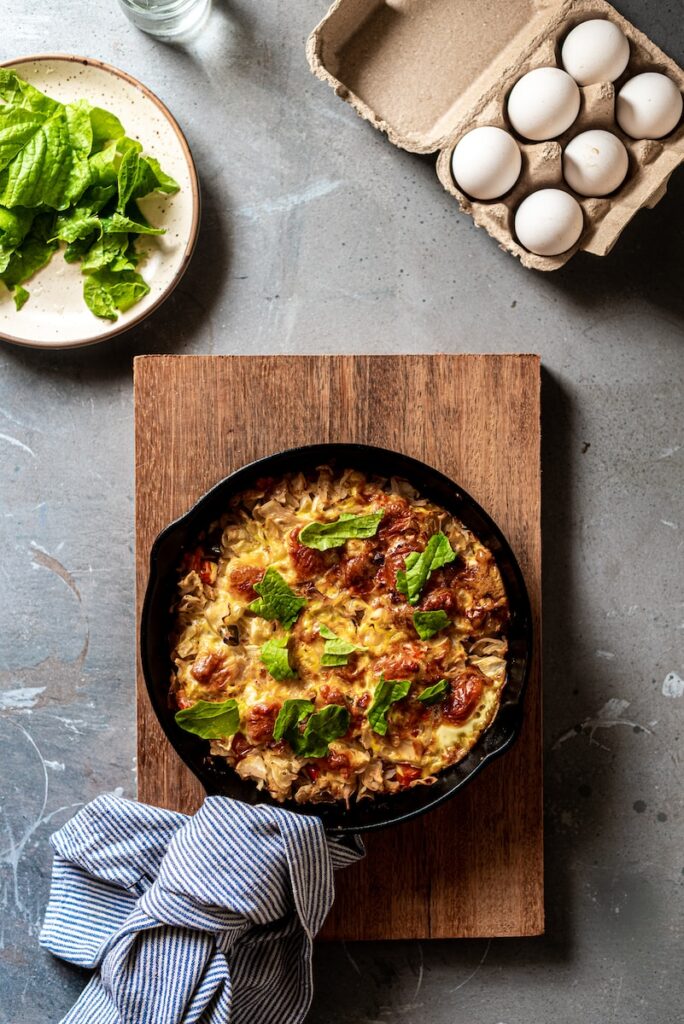Rated & Reviewed is reader-supported. When you buy through links on our site, we may earn an affiliate commission. Learn more.
Cast iron skillets have been a staple in kitchens for centuries, known for their durability and excellent heat retention. However, to maximize their performance and ensure longevity, it is crucial to season them properly. In this article, we will walk you through the process of seasoning a cast iron skillet and explain its importance. So, let’s dive right in!
What is Seasoning for a Cast Iron Skillet?
Seasoning refers to the process of treating a cast iron skillet’s surface with oil, creating a natural non-stick coating. This protective layer not only prevents food from sticking but also helps to enhance the flavor and improve the skillet’s overall performance.

Why Season a Cast Iron Skillet?
There are several reasons why seasoning a cast iron skillet is essential:
1. Non-stick surface: Seasoning forms a layer that fills the microscopic pores in the skillet, reducing the chances of food sticking to it.
2. Improved heat distribution: Proper seasoning helps to maintain and distribute heat evenly across the surface of the skillet, promoting better cooking results.
3. Rust prevention: The oil used during seasoning acts as a barrier, preventing moisture from coming into direct contact with the iron and reducing the risk of rust formation.
4. Enhanced flavor: Over time, the seasoning layer develops its own unique flavor profile, imparting a distinct taste to your dishes.
Now that we understand the importance of seasoning, let’s move on to the process of cleaning and seasoning a cast iron skillet.
How to Clean a Cast Iron Skillet
Properly cleaning your cast iron skillet is essential for maintaining its seasoning and preventing rust. Follow these steps to effectively clean your skillet:
- Allow the skillet to cool down completely after cooking. Never clean it while it is still hot.
- Scrape off any food residue or stuck-on bits using a stiff brush or a plastic scraper. Avoid using metal utensils or abrasive scrubbers as they can damage the seasoning.
- If the skillet has stubborn residue, you can add a small amount of kosher salt to act as an abrasive. Use a damp cloth or paper towel to scrub the salt around the surface.
- Rinse the skillet with warm water to remove any loosened residue. Make sure to fully remove all the salt or any other cleaning agents used.
- Using a dry cloth or paper towel, thoroughly dry the skillet. It is crucial to remove any moisture to prevent rusting.
How to Season a Cast Iron Skillet
Once your cast iron skillet is clean and dry, it’s time to season it. Follow these steps to properly season your skillet:
- Preheat your oven to 350 degrees Fahrenheit (175 degrees Celsius).
- Apply a thin layer of oil to the entire surface of the skillet, including the handle and the outer edges. You can use vegetable oil, flaxseed oil, lard, or Crisco for seasoning.
- Place the skillet upside down on the oven’s middle rack. This allows any excess oil to drip off and prevents pooling.
- Bake the skillet for 1 hour. The high heat helps the oil penetrate the iron and form a strong seasoning layer.
- Turn off the oven and leave the skillet in the cooling oven for another hour. This slow cooling process further enhances the seasoning.
- Remove the skillet from the oven and allow it to cool completely before using or storing.
What Oils to Use for Seasoning a Cast Iron Skillet
Choosing the right oil for seasoning your cast iron skillet can make a difference in the quality of the seasoning. Here are some commonly used oils:
- Vegetable oil: This is a popular choice due to its affordability and accessibility. It creates a decent seasoning layer but may not be as durable as other options.
- Flaxseed oil: Known for its high smoke point and polymerization properties, flaxseed oil is often considered the best choice for seasoning cast iron. It forms a hard and slick coating suitable for high-heat cooking.
- Lard: Traditional fats like lard can also be used for seasoning. They tend to create a durable and non-sticky coating.
- Crisco: Vegetable shortening like Crisco can also be used for seasoning. It forms a solid and durable layer, but it may not provide the same non-stick qualities as other oils.
Experiment with different oils to find the one that works best for you and your cooking preferences. Remember to always use oils with high smoke points to avoid damaging the seasoning.
How to Maintain a Cast Iron Skillet
Maintaining a cast iron skillet is essential to ensure its longevity and optimal performance. Here are some tips on how to maintain your cast iron skillet:
1. Clean it properly: After each use, clean your cast iron skillet with warm water and a stiff brush or sponge. Avoid using soap as it can strip away the seasoning. Make sure to remove any food residues and dry the skillet thoroughly.
2. Avoid soaking: Never soak your cast iron skillet in water as it can lead to rusting. Instead, clean it immediately after use and dry it completely.
3. Re-season when needed: Over time, the seasoning on your cast iron skillet may start to wear off. If you notice food sticking to the surface or a dull appearance, it’s time to re-season it. Follow the steps mentioned in Section V to re-season your skillet and restore its non-stick properties.
4. Store it properly: Store your cast iron skillet in a dry place to prevent moisture from accumulating. If you stack multiple skillets together, place a paper towel or a cloth between them to avoid scratching or damaging the seasoning.
5. Avoid acidic foods: Limit the use of acidic foods, such as tomatoes or vinegar-based sauces, in your cast iron skillet. Acids can strip away the seasoning and cause metallic flavors in your food.
Tips for Keeping your Cast Iron Skillet in Good Condition
Here are some additional tips to keep your cast iron skillet in good condition:
1. Avoid extreme temperature changes: Rapid temperature changes can cause your cast iron skillet to warp or crack. Allow it to cool naturally after cooking before cleaning or exposing it to cold water.
2. Use gentle utensils: Avoid using metal utensils, such as knives or forks, which can scratch or damage the seasoning. Opt for wooden or silicone utensils instead.
3. Regularly use your skillet: Regularly cooking with your cast iron skillet helps in building and maintaining the seasoning. The more you use it, the better it will perform.
4. Remove stuck-on food: If you encounter stubborn food residues that are difficult to remove, sprinkle some coarse salt on the skillet and scrub it with a cloth or brush. The salt acts as an abrasive and helps in loosening the stuck-on food.
5. Avoid high heat: While cast iron skillets are known for their ability to retain heat, avoid using excessively high heat, as it can damage the seasoning and cause food to stick.
Pros and Cons of Using a Cast Iron Skillet
Pros:
- Excellent heat retention and distribution, resulting in even cooking.
- Durable and long-lasting.
- Naturally non-stick when properly seasoned.
- Versatile – can be used on stove tops, in ovens, and even on campfires.
- Chemical-free cooking surface.
Cons:
- Requires maintenance and regular seasoning.
- Can be heavy and difficult to handle.
- Not suitable for cooking highly acidic foods for prolonged periods.
- Prone to rust if not properly cared for.
Wrapping Up How to Season a Cast Iron Skillet
Maintaining and seasoning a cast iron skillet is crucial for its longevity and optimal performance. By following the proper cleaning and seasoning techniques, as well as implementing proper maintenance practices, you can enjoy the benefits of cooking with a cast iron skillet for years to come. Remember to clean it properly, avoid soaking, and re-season when needed. Use gentle utensils, avoid extreme temperature changes, and regularly use your skillet to maintain its seasoning. Despite the maintenance requirements, the excellent heat retention, durability, and non-stick properties make a cast iron skillet a worthwhile addition to any kitchen.
FAQs for How to Season a Cast Iron Skillet
1. Why is it important to season a cast iron skillet?
Seasoning a cast iron skillet helps create a non-stick surface, prevents rusting, and improves the overall flavor of your food.
2. How often should I season my cast iron skillet?
It is recommended to season your cast iron skillet after every use or as needed, especially if the seasoning begins to wear off.
3. Can I season my cast iron skillet in the oven?
Yes, seasoning a cast iron skillet in the oven is a common method. It allows for even heating and creates a durable seasoning layer.
4. What is the best oil to use for seasoning a cast iron skillet?
While there are various oils that can be used, commonly recommended oils for seasoning a cast iron skillet include vegetable oil, flaxseed oil, lard, and Crisco.
5. Can I use soap to clean my cast iron skillet?
Contrary to common belief, it is safe to use mild soap to clean your cast iron skillet. Just make sure to thoroughly dry it after washing to prevent rusting.
6. How should I store my cast iron skillet?
After cleaning and drying your cast iron skillet, it is best to store it in a cool, dry place. Placing a paper towel or cloth between stacked skillets can prevent moisture buildup.
7. How can I remove rust from my cast iron skillet?
If your cast iron skillet develops rust, scrub it with steel wool or a stiff brush, rinse well, and re-season it before using again.
Amazon and the Amazon logo are trademarks of Amazon.com, Inc, or its affiliates.

